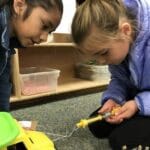What’s school without grade levels?

In math teacher Danielle Bosse’s classroom, three students take assessments (foreground) while their classmates learn and practice different math skills.
HUNTER, N.D. — On windswept fields outside Fargo, North Dakota, a bold experiment in education has begun. In a lone building flanked by farmland, the Northern Cass School District is heading into year two of a three-year journey to abolish grade levels. By the fall of 2020, all Northern Cass students will plot their own academic courses to high school graduation, while sticking with same-age peers for things like gym class and field trips.
The goal is to stop tethering teaching to “seat time” — where students are grouped by age and taught at a uniform, semester pace — and instead adopt competency-based education, in which students progress through skills and concepts by demonstrating proficiency.
That alone isn’t unusual; a majority of states now allow competency-based pilot programs, and many schools have fully implemented the approach. What makes Northern Cass notable is that very few mainstream schools, let alone districts, have set out to topple grade levels.
But as the movement against seat-time learning grows, more schools nationwide will be grappling with grade levels, deciding whether to keep them or to hack through thickets of political, logistical and cultural barriers to uproot them.
Some school leaders insist that competency-based education can survive and even thrive within grade levels, or a modified version of them. Others, however, echo Northern Cass superintendent, Cory Steiner.
“We can’t keep structures that would allow us to fall back into a more traditional system,” said Steiner. “If we’re going to do this, we’re going to have to manage without grade levels.”
***
One recent spring afternoon, about a dozen Northern Cass students working on laptops made themselves comfortable in a large classroom with mobile furniture, beanbag pillows and a plush blue couch.
We’ve decoupled the curriculum from those grade levels. You are studying what you need to study at your level.
Bill Zima, superintendent, Kennebec (Maine) Intra-District Schools regional school unit #2
The kids were rounding out eighth or ninth grade, but that had little to do with their choices of self-paced lessons in several subjects. Some had finished all the material pegged to their grade level months ago and had moved on, while others were taking more time.
Two teachers, known as “academic advisors,” were on call to field questions and ensure everybody stayed on task (the teachers also lead weekly seminars or labs to bolster the computer work).
These students, and a couple dozen others circulating through the classroom for three periods each day, make up Jaguar Academy (named for the district’s feline mascot). As a first-year pilot, Jaguar Academy is just part of the larger overhaul. But it’s one of the district’s first steps toward a grade-free future.
For students like Katelyn Stavenes, reclining on the couch and catching up on science she missed during an illness, Jaguar Academy is a welcome taste of autonomy.
“I can just lean back and do my stuff instead of always watching the clock and wondering, when can I get out of here?” said Stavenes, who will be a ninth-grader this fall.
Meanwhile, at one of the tables in the hallway set up for kids working together, a girl named Silver Anderson said that doing three courses in Jaguar Academy (physical science, English and American history) gave her the schedule flexibility to meet with the band teacher on Friday mornings for an informal class in music theory and composition.
“I’ve been experimenting with chord progressions,” she said. “There’s so much behind music to learn.”

Northern Cass student Katelyn Stavenes taking part in the Jaguar Academy pilot, a piece of the district’s plan to eliminate grade levels by the fall of 2020.
The district plans to expand the pilot until it’s an option for all students in what are now called the eighth through twelfth grades. And, beyond Jaguar Academy, Northern Cass educators are rewriting lessons and assessments, both for academic subjects and for “habits of work,” such as perseverance and collaboration, into progressions of competencies free of grade-level expectations. They have spent evenings and school breaks shuffling teacher schedules and prepping for competency-based classrooms; they’ve visited other schools around the nation that have a head start down this road; they’ve added another guidance counselor to beef up internship opportunities for older students; and they’ve held several workshops to explain it all to parents.
“I’d love to tell you we have every answer,” Steiner said, but “we’ve got a long way to go.”
***
While seat-time schooling is fiercely opposed by reformers, it is backed by state and federal law. Northern Cass’s reforms rely on North Dakota’s 2017 decision to let districts apply for waivers from requirements such as hours of instruction.
Most states have something on the books to encourage competency-based options, but only about a half-dozen have loosened seat-time dictates enough to dispense with grade levels, according to Matt Williams, chief operating officer and vice president of policy and advocacy for the personalized-learning nonprofit KnowledgeWorks.
In North Dakota, Williams and his colleagues worked with Kirsten Baesler, the state superintendent of public instruction, to write the waiver bill, and Northern Cass leaders lobbied legislators to pass it.
They pushed for radical change even though North Dakota districts were doing well by traditional measures, such as graduation rates, ACT scores and the National Assessment of Educational Progress, on which the state regularly ranks among the top fifteen in most subjects and grade levels tested.
We’ll do whatever we have to do for testing. But we won’t put any extra effort or incentive into them. They’ll be something we have to do and move on.
Cory Steiner, superintendent, Northern Cass (N.D.) school district
According to Baesler, however, “We were too often teaching to a test. Educators wanted students to engage more and apply their learning in meaningful ways.”
At Northern Cass, momentum for change began during the district’s 2016 accreditation renewal when staff checked up on students after graduation. They found that graduates’ college grades tended to dip compared to their high-school GPAs, and the students bounced around a lot — switching majors, transferring to other universities or dropping out. District leaders decided they hadn’t done enough to prepare students for life after high school.
According to Melissa Uetz (pronounced yoots), a special education teacher who became Jaguar Academy’s lead facilitator, the message was, “We needed to help kids find their passions before they left school.”
That meant more flexibility and potential for exploration in student schedules. The primary goal for Jaguar Academy was to give high school students more opportunities for job shadows and internships. More proposed changes spiraled out from there, including the decision to do away with grade levels.
“Teachers said, ‘If this is good for kids, why not bring it to all of them?’ ” said Steiner. “Our conversation went from Jaguar Academy to ‘What if we tore the whole system down?’ ”
Of course, no matter what individual states and districts allow, federal law still mandates grade-level-pegged testing. Education departments use those scores to evaluate schools. Quite often, so do parents.
California’s Lindsay Unified School District, which switched to competency-based education years ago and has been mentoring Northern Cass, kept grade levels because of standardized tests. Lindsay Unified’s director of advancement, Barry Sommer, said he would love to scrap grade levels, because they get in the way of “truly moving to a 21st-century school that’s learner centered.” But California’s district-accountability tracking system is based on grade-level achievement tests.

Northern Cass students Jaenna Wolff (left) and Abby Richman work on history and physical science, respectively, at the Jaguar Academy.
Meanwhile, even the handful of schools that have successfully ditched grade levels, such as Waukesha STEM Academy, a charter school about 20 miles west of Milwaukee, must still keep age-based groupings in the background to sort students for standardized testing.
“We take the tests. But we don’t think much about them, quite honestly,” said James Murray, Waukesha’s principal.
Steiner plans a similar approach. For testing and student data reporting, Northern Cass will still link students with an expected year of graduation.
“We’ll do whatever we have to do for testing,” said Steiner. “But we won’t put any extra effort or incentive into them. They’ll be something we have to do and move on.”
***
Jaguar Academy is often library-quiet. Prepackaged lessons from an online curriculum provider comprised about 80 percent of students’ work in the first year. Steiner wants to cut that online learning quotient way back, to 20 percent, partly by expanding the number of seminars in which teachers lead a deeper exploration or a lab on select topics.
Still, it has been hard enough to schedule just one weekly seminar, he said. Students often skip a non-Jaguar Academy class to attend, and there have been no math seminars, because none of the academic advisors are math teachers.
And seminar scheduling is just one of the logistical headaches Northern Cass will face as grade levels disappear.
“Competency-based schools still need structures — they just need new structures,” said Sydney Schaef, a mastery learning designer for reDesign, a Boston company that guides school overhauls. “We still need ways to identify where kids need to be when they come into the building in the morning.” And when kids should stop going to elementary school and start attending a middle school across town. (Because the Northern Cass district is in a single building, they dodge that particular challenge.)
“Even reimagining space is bigger than any of us thought,” said Steiner. “Classrooms that used to be owned by a teacher will have to be more flexibly used. We’re looking at one of our gyms and asking, does it have to double as a classroom space?”
Then there’s the question of whether to place limits on how quickly or slowly students move through competencies. For instance, another of the districts mentoring Northern Cass found that just letting students work “at their own pace” led some kids to slack off and disrupt classmates.

Northern Cass student Myles Froehlich works out fractions with the help of dominoes.
“I remind teachers that we need to put some controls on this,” said Bill Zima, superintendent of the district in question, Maine’s Kennebec Intra-District Schools regional school unit #2 (RSU2). “First-graders are not ready to completely manage their time. Nor are seniors. Nor are adults, really.”
The solution for some is grouping kids who would traditionally be in two or three different grade levels together in a single classroom, a longstanding practice of Montessori schools.
“A lot of schools are finding ways to blur grade levels rather than getting rid of them,” said Karla Phillips, policy director for personalized learning at the Florida-based Foundation for Excellence in Education, or ExcelinEd.
At Northern Cass, teachers plan to step in if a student gets more than three weeks behind or ahead of an expected “teacher pace.” Students who struggle will get extra support. Students who speed ahead will get a conversation about next steps.
“Maybe we let them fly,” said Steiner. “Or maybe they want to do an independent project, or work as a peer teacher or go back to work more on a competency where they’ve struggled.”
Meanwhile, the district is reworking teacher assignments to better fit a school where age and academics are no longer tied together. Last year, for example, the elementary teachers stopped being generalists and started to specialize. The idea is that teachers will encounter students in a broader range of ages and abilities, but only in their own academic areas of expertise.
“We asked, who’s passionate about math, writing or science, and so forth. And we ran with it,” Steiner explained.
We were too often teaching to a test. Educators wanted students to engage more and apply their learning in meaningful ways.
Kirsten Baesler, North Dakota state superintendent of public instruction
One early adopter was math teacher Danielle Bosse. On a typical day, most of her students spread around the classroom, working independently on math skills, while one or two at a time pull up a chair to Bosse’s desk for a coaching session. Kids who feel ready to move on ask Bosse to unlock an online test, which they take at a table topped with black cardboard dividers.
Asked how students have adjusted, Bosse said, “Standard operating procedures. We did a lot of standard operating procedures.”
Known around Northern Cass as “SOPs,” these procedures are co-developed by students and teachers to help kids manage their time and stay organized. An SOP might require students to take out planners at the start of class and jot down their learning targets or put their names on a whiteboard next to the competency they are working on that day.
The SOP brainstorming began last October, after many students struggled with their newfound autonomy. In fact, Steiner’s plan is to start this coming fall with a week devoted just to SOPs and other “soft skills,” such as critical thinking.
“All these key skills we want kids to learn, like time management,” he said, “we need to teach them very explicitly.
***
After cutting the regulatory red tape and solving the logistical puzzles, a deeper challenge remains in the move away from seat-time. Grade levels are part of our culture, deeply rooted in how we think about learning and childhood more broadly.
If we’re going to do this, we’re going to have to manage without grade levels.
Cory Steiner, superintendent, Northern Cass (N.D.) School District
“When you meet somebody and ask how old their kids are, they say, oh, they’re in third grade or fourth grade,” noted Phillips of ExcelinEd.
Cultural norms have kept grade levels partially intact in Maine’s RSU2 district, which has hosted Steiner and Northern Cass teachers many times.
“We’ve decoupled the curriculum from those grade levels,” said RSU2’s Zima. “You are studying what you need to study at your level.” But, he added, the district has kept the grade levels as a “social moniker.”
Even Waukesha STEM Academy gives grade levels a cameo in student progress reports. “Parents still wanted to know how their kid was doing compared to a kindergarten through 12th-grade scale,” said superintendent Murray. So, the school added a grade-level scale across the top of report cards that mostly measured student progress along broader “learning continuums.”
“Parents had the comfort of seeing the old system while being aware that the new system and progression was in place in school,” said Murray.
Some competency-based schools want to keep grade levels for reasons beyond offering parents a safety blanket. Grade levels, they argue, can give students a sense of camaraderie and enhance social learning. For instance, at Casco Bay High School, in Portland, Maine, two or three interdisciplinary “learning expeditions” a year are arranged by grade level. Last year, a junior-year expedition had teams of students visit rural Maine to interview local “unsung heroes” and create mini-documentaries about them. that were stitched into a large, single documentary for the entire grade.
“There’s an element of ‘we’re all in this together.’ We’re all taking on the same complex project,” said the Casco Bay principal, Derek Pierce. “Our kids support each other, and they are really good at giving each other feedback, because the quality of your project will reflect on the whole project and, therefore, reflect on me.”
Back at Northern Cass, however, they believe that grade levels would become a crutch for students and teachers and ultimately stymie reform. “All of us have a pit in our stomach right now,” said Steiner. “We know that we’re taking a big leap and not everybody’s going to be on board.”
This summer, Northern Cass teachers and administrators have continued rewriting lesson plans and assessments, including those for “habits of work.” They’ve also been visiting more-experienced competency-based districts such as Lindsay Unified. By 2020, Steiner wants Northern Cass to be the district hosting visitors, as a mentor to other schools mulling the idea of nixing grade levels.
“On their way to visit Lindsay or another of these pioneering schools, they can stop in North Dakota,” Steiner said, “because there’s a school out in the middle of a cornfield that’s doing this transformative work.”
Source: HechingerReport
Last Updated on 6 December 2023
We cover inequality and innovation in education with in-depth journalism that uses research, data and stories from classrooms and campuses to show the public how education can be improved and why it matters.





